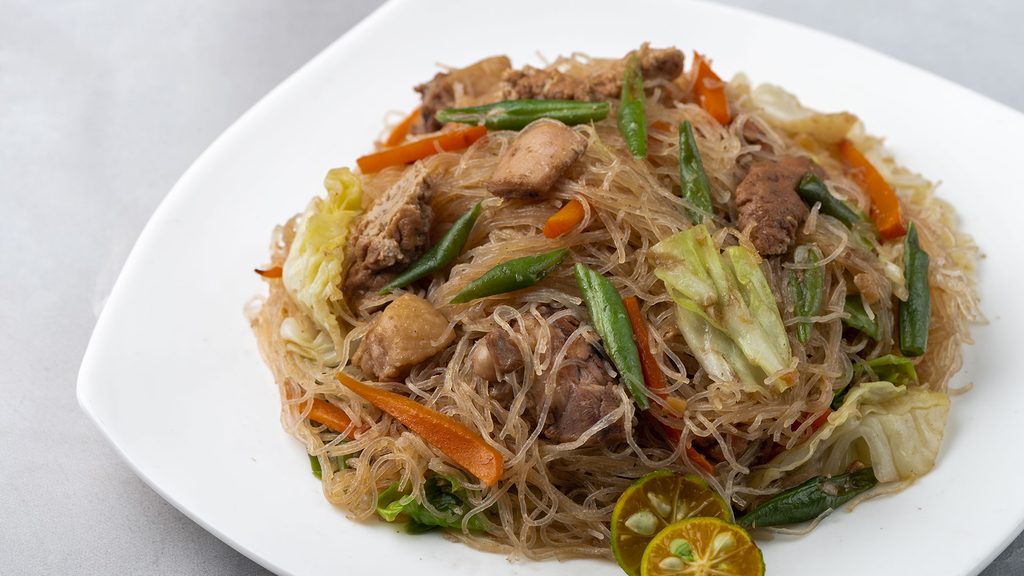SUMMARY
This is AI generated summarization, which may have errors. For context, always refer to the full article.

MANILA, Philippines – What’s the difference between pancit bihon and pancit canton? How does pancit malabon differ from pancit palabok? In the Philippines, pancit is life, but with so many regional varieties, it’s common to get confused.
The word “pancit” comes from the Hokkien term “pian-e-sit,” which means “conveniently cooked,” like fast food. The noodle dish was said to have been brought to the Philippines by Chinese immigrants centuries ago and was eventually localized as a staple Filipino dish during the Spanish colonization. It has since become a widespread mainstay for Filipino celebrations and milestones, signifying the Chinese tradition of noodles carrying “long life,” according to Pepper.ph.
Different regions and cities have their own versions of pancit, with each one distinctly its own, using a variety of noodles, vegetables, meats, seafood, ingredients, sauces, and even methods of cooking. So, if you’ve been looking for a quick guide to help you out, dish is it, pancit! Here are some well-loved pancit dishes from across the country!
Pancit bihon
Probably one of the most famous iterations, the Filipino stir-fry noodle dish pancit bihon also comes with “guisado” in its name, which means to sauté.

This dish is composed of thin rice noodles that are stir-fried in soy sauce and, at times, oyster sauce. It is seasoned with calamansi juice and typically served with sliced pork, shredded chicken, sometimes liver, and various vegetables like garlic, onion, green beans, cabbage, carrot, snow peas, and more.
Pancit canton

Also a popular choice, pancit canton uses almost the same ingredients as bihon but is made from egg/wheat flour noodles instead. This stir-fry dish is also seasoned with soy sauce and calamansi juice and can sometimes have shrimp, eggs, beef, and other ingredients and seasonings.
Pancit palabok
Served in several Filipino food stalls, canteens, and fast-food restaurants, pancit palabok is a staple noodle dish that uses thin, translucent rice noodles topped with a rich and thick seafood-based sauce typically made from shrimps. The savory and creamy sauce gives the dish its signature bright-orange color and umami flavor.

The noodles are served with a variety of toppings – crunchy chicharon (pork crackling) bits, shrimp, scallions, pork, smoked fish, eggs, and crunchy garlic bits.
Pancit malabon
Not to be confused with fellow orange dish pancit palabok, pancit malabon is Malabon City’s pancit pride and joy. Malabon’s version uses thicker rice noodles with its sauce already mixed in. The flavorful shrimp-infused sauce typically has crab fat and/or patis (fish sauce) and other seafood like shrimp, mussel, or squid. It is also topped with chicharon bits, sliced cabbage, dried fish, eggs, and other ingredients. Since Malabon City is a coastal region, fresh and local seafood is the star of this noodle dish.

Pampanga’s pancit luglug is quite similar to palabok and malabon, just saucier and made with cornstarch noodles that are thicker than palabok’s. The term “luglog” comes from the translation “to dunk in water,” which is what is done to the thick rice noodles to make them softer. It is also a seafood-forward noodle dish, topped with fresh seafood, scallions, and hard-boiled eggs.
Pancit habhab
Pancit habhab, which resembles pancit canton, originated from Lucban, Quezon province, and is a dish that uses the chewy Filipino egg noodles called miki noodles. The name comes from the way it’s traditionally eaten, “to gobble up” – the cooked pancit is placed on a banana leaf and then “dumped” into the eater’s mouth. No utensils here!

Pancit habhab is a stir-fry dish usually made with soy sauce, pork belly, liver, shrimp, and veggies like sayote, carrots, and bok choy/pechay. It’s served with calamansi juice and/or spiced cane vinegar.
Pancit batil patung

Hailing from Tuguegarao, pancit batil patung is made from stir-fried miki noodles mixed in with minced carabao meat (a staple protein of the region), bean sprouts, seafood, liver, and veggies, topped with chicharon and egg. It is typically served with a poached egg on top, which means “patong.” The word “batil” comes from the “beaten egg” soup-sauce that the dish is traditionally served with.
Pancit bato
The noodle dish from Bato, Camarines Sur, is a Bicolano delicacy that is similar to pancit canton but uses thicker noodles that are sun-dried and dehydrated first to give a distinctly smoky flavor. Once the noodles are boiled, they are stir-fried with garlic, onions, soft sauteéd pork (that are simmered in chicken stock prior), salt and pepper, shrimp, and vegetables like carrot, bok choy, snap peas, and more. Sometimes, patis is added for extra flavor.
Bam-i (pancit bisaya)
Cebu’s Bam-i or pancit bisaya is a Central Visayas favorite that uses two kinds of noodles – canton and bihon – quickly cooked together with pork, chicken, Chinese sausage, shrimp, cabbage, tenga ng daga (dried wood ear), carrot, and other veggies. It is seasoned with soy sauce and chicken stock, usually, and is known for its different noodle textures and thickness.
Pancit langlang
The comforting pancit langlang from Imus, Cavite, has miki noodles and sotanghon (rice) noodles stir-fried with garlic, onions, shredded chicken, ground pork, quail eggs, chicharon, with veggies like carrot, cabbage, string beans, and more. It is considered a soupy noodle dish and is even hailed as Jose Rizal’s favorite from Cavite – he called it “the soup par excellence!” in El Filibusterismo.
Pancit lusay
Pancit lusay is an Ilocos favorite made of “lusay noodles” or miki noodles, stir-fried with Ilocos’ famed Laoag longganisa, garlic, onion, tomato slices, egg, bell peppers, and bagoong alamang or isda, which gives the dish its distinctly umami taste.
Let us know your other regional pancit favorites! – Rappler.com
Add a comment
How does this make you feel?
There are no comments yet. Add your comment to start the conversation.